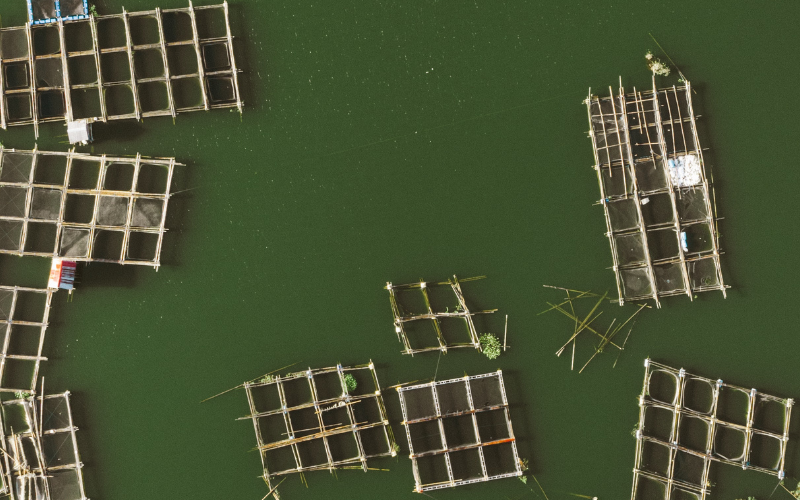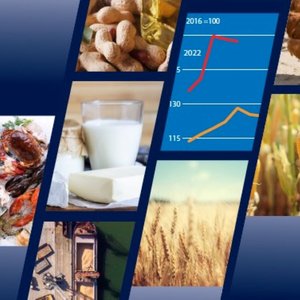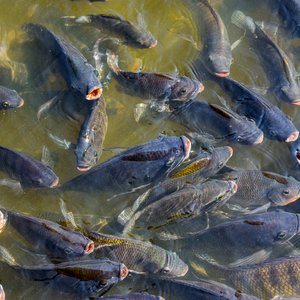Many of the world’s largest aquatic food producers are highly vulnerable to human-induced environmental change, with some of the highest-risk countries in Asia, Latin America, and Africa demonstrating the lowest capacity for adaptation, a landmark study has shown. The study shows that more than 90% of global “blue” food production, in both capture fisheries and aquaculture, faces substantial risks from environmental change, with several leading countries in Asia and the United States set to face the greatest threats to production.
The authors behind the new paper produced the first-ever global analysis of environmental stressors impacting the production quantity and safety of blue foods around the world, ranking countries according to their exposure to key stressors for the first time. A total of 17 stressors were surveyed, including harmful algal blooms, sea level rise, changing temperatures, pesticide exposure, and more.
Alongside climate change, the report highlights that highly vulnerable blue food production systems are found across all continents, including some of the world’s largest blue food producers such as Norway, China, and the United States, yet also argues there is too often a lack of understanding around the complexity of stressors causing environmental change.
“We have only scratched the surface in our understanding of how environmental stressors are connected, and how they can both negatively impact the production and safety of the resulting blue foods,” said Ling Cao, co-lead author and professor at the State Key Laboratory of Marine Environmental Science at Xiamen University. “Understanding the complexity of these stressors, and their cascading impacts, will be essential in developing successful adaptation and mitigation strategies.”
Species invasion, inland eutrophication or the over-enrichment of water bodies with nutrients, ocean warming, and sea level rise were cited by the paper as the main threats to blue food production in the US, with freshwater and marine fisheries facing disproportionately large risks. As the largest blue food producer, China’s freshwater aquaculture is also highly exposed to inland eutrophication and severe weather events, the research shows.
The authors also argue that special attention should be paid to countries facing high exposure to environmental change yet not possessing adequate capacity for adaptation, including Bangladesh, Benin, Eswatini, Guatemala, Honduras, Togo and Uganda.
In terms of production systems, the paper finds that marine fisheries were generally more vulnerable to climate-related stressors, particularly rising temperatures and acidification, while aquaculture was more susceptible to the effects of diseases and hypoxia, or low oxygen levels.
“Although we have made some progress with climate change, our adaptation strategies for blue food systems facing environmental change are still underdeveloped and need urgent attention,” said Rebecca Short, co-lead author and researcher at the Stockholm Resilience Centre.
Among the report’s key recommendations is a call for more transboundary collaboration and adaptation strategies which recognize that the ecosystems that blue food production relies upon are highly interconnected, with environmental change in one area having potential knock-on effects elsewhere.
“In addition to studying the direct effects from stressors, it is also important to broaden the scope and consider how supporting systems are impacted – for example, feed production systems providing inputs for aquaculture,” said Max Troell, co-author and associate professor at the Stockholm Resilience Centre.
The authors also call for a diversification of blue food production in high-risk countries to cope with the impact of environmental change unless sufficient mitigation and adaptation strategies are adopted.
Likewise, the paper highlights the urgent need for greater stakeholder engagement in understanding, monitoring, and mitigating pressures on blue food production systems. Indigenous knowledge will be critical for strategic planning and policies to mitigate and adapt to environmental change, particularly for artisanal fisheries and heavy marine fisheries-dependent countries, such as Small Island Developing States (SIDS).
The research also includes an extended dataset that ranks countries around the world based on the exposure of their blue food production systems to various environmental stressors.
The research published by Nature Sustainability and entitled Vulnerability of Blue Foods to Human-induced Environmental Change has been produced as one of eight initial scientific papers published by the Blue Food Assessment (BFA) as part of a global effort to inform aquatic food sustainability into the future.










